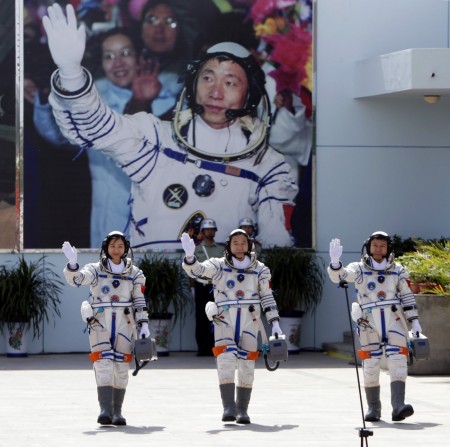China’s success in space science
The successful launch of spacecraft has given tremendous impetus for the Chinese authority to push further on the ambitious mission of building a space station by 2020. The 13-day manual docking mission, carrying three, including first Chinese astronaut Liu Yang, has completed with the capsule landing on earth in Inner Mongolia.
Premier Wen Jiabao hailed the mission as a “complete success”. “This is another outstanding contribution by the Chinese people to humanity’s efforts to explore and use space,” he Wen said in Beijing.
The crewmembers were all smiles, looked energized with the success as they emerge out of the return capsule. They are all young and energetic.
“It feels so good to stand on Earth, and it feels even better to be home,” astronaut Liu Wang, was quoted by national broadcaster CCTV as saying.
The Shenzhou-9 mission has set several historical records, as longed talked by Beijing about its three-step strategies, that it was the first manned automatic and manual dockings; the first long-duration spaceflight; and the first crew to live aboard a permanently orbiting module, Tiangong-1.

The mission not only invited world attraction being the first Chinese attempt but also due to female participation. The Chinese mission has given lift to women’s success in space studies. Russia had put female into space shuttle 49 years ago.
According to BBC, Ms Liu, 33, is a major in China’s air force from the central province of Henan. On China’s Tencent QQ messaging service, she goes by the name “little Flying Knight”.
Chinese news agency Xinhua said, she was recruited into China’s space programme only two years ago, but she excelled.
Chinese authorities have announced that they will deploy bigger spacecraft for longer missions, as part of the 20-year space programme that has cost more than $6 billion so far. The second mission, likely by end next year, will be the last docking with the Tiangong-1, which was put into orbit in September last year.
Then, in a few years, China will launch a more sophisticated version, the Tiangong-2, AFP reported.
The news agency quoted Joan Johnson-Freese, a professor at the US Naval War College, as saying that China is also developing the Long March 5, a next-generation booster rocket that will be needed if the nation hopes to place a bigger space station in orbit.
This is likely to replace the current International Space Station run jointly by American, Japanese, Canadian, Russian and European space agencies by 2020 when its life expectancy expires. China has never been invited to join the ISS.
Despite the success, Chinese space programme is far behind compared to advancement of US space studies. This was highlighted by the fact that American tested the manual space docking trumpeted by the Chinese today in the 1960s.
United States, after retiring its space shuttle fleet, is also developing a new rocket and technologies to place a man on an asteroid or on Mars. It takes some more years for China to compete with US, but not unlikely. Unless, they run on the same footing, it won’t look like competition. Chinese authorities say, they are not competing with anyone on their space programme. If there are any competitions, it might be within Asia, where India also has put ambitious plans for space studies.
Joint efforts from all these countries would have given better results. The latest success will put pressure on western countries to open doors for China into ISS programmes.